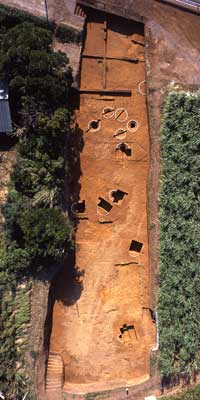Ōtsubobata:
The oldest pit traps in Japan? Warm Tanegashima's Paleolithic
upsets the prevailing image of this era.

Paleolithic sites of Tanegashima


The site from above Distribution of
features |

Strata in
cross-section | |


The oldest pit
traps in Japan | |
Ōbotsubata Site, Tanegashima Town, Kagoshima Prefecture
A discovery in central Tanegashima
Ōtsubobata is an Upper Paleolithic site located on the southern edge of Tashima tableland, which stands some 25 m in elevation on the central part of Tanegashima island. The vicinity is complexly penetrated by valleys, and 12 pit traps were found on the western slope of one of these. Approximately 150 m to the south is Tachikiri (ca 30,000 BP), held to be the oldest site of human livelihood in Japan.
Grave, storage pit, or trap?
These features were not immediately understood to be traps when they were discovered in 2002. As they possibly could have been graves or storage pits, they were simply referred to as earthen pits while being investigated. As the work proceeded, it was seen that the pits had filled in naturally, so it became clear they were not graves. That is because when a corpse is interred the grave is buried all at once, and thus cannot fill in naturally.
But what about storage pits? No stone tools were recovered near the pits, so it was understood that Paleolithic man was not living at the location. If they were for storage, it is unlikely they would have been made at a spot far removed from the place of livelihood, and moreover as scientific analysis of the soil from the pits yielded no results proving use for storage, it is difficult to see them as pits for that purpose.
From the lack of stone tool finds, the possibility arose that the vicinity of the pits was rather a hunting ground. It was pointed out by a committee of experts, assembled during the excavation to investigate the issue, that the shape was close to pit traps of approximately 27,000 BP discovered in Shizuoka prefecture, and at present it is judged most reasonable to regard the pits as traps based on the conditions of the fill, the surrounding area, and their shape.
Pit traps made on a game trail
Based on the results of scientific (plant opal) analysis of components of the soil in the vicinity of the pits, the possibility that the region was a broadleaf evergreen forest has been pointed out.
Grinding and pounding stones have been recovered from the Tachikiri and Yokomine sites of the southern part of Tanegashima, and it is conceivable that materials such as nuts were ground and eaten. Also, a cooking area where cobbles were gathered and fire was made has been found at the Yokomine site, and it is inferred that baking was done there.
The pit traps concentrate at places where the valley slope is gradual, and possibly they were positioned on a game trail leading down into the valley. While some are of the opinion, based on these factors, that wild boar living in the forest were targeted, what was caught is a topic needing investigation in the future.
Although the existence in the warm Tanegashima climate of a Paleolithic culture differing from that of the main Japanese islands, which utilized plant foods, had been pointed out, the methods of hunting of the time were unclear. This discovery shows on the one hand that hunting with pit traps has been conducted on Tanegashima from approximately 30,000 years ago, while providing significant results from the field for considering the origins of pit traps, and the regional variation of Paleolithic culture, in the Japanese archipelago. (Yamamoto Ken'ichi, Kawaguchi Masayuki)
